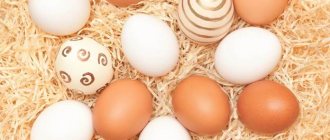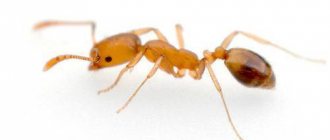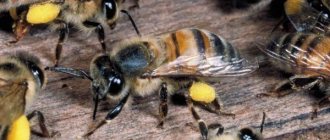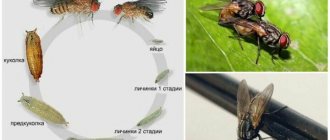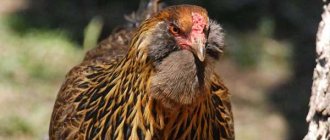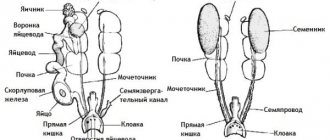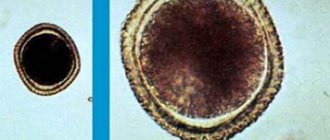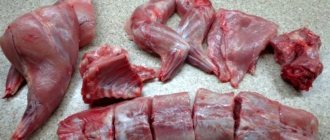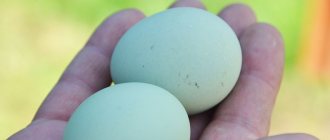At first glance, an egg, such a common food product for people, has a very complex structure that is difficult to imagine. Even the most insignificant element, it would seem, is called upon to perform important functions in the process of giving birth to a chick. The article examines the detailed structure of an egg laid by a chicken.
How eggs are formed
In birds they form in the ovary and oviduct . An adult female bird has hundreds of immature germ cells in its ovary. By the time oviposition occurs, the reproductive cells begin to grow, accumulate nutrients and turn into yolks. About once a day, a mature yolk enters the oviduct.
The yolk moves through the oviduct, in the process the protein secreted from the glands of the walls is layered on it. Next, in the section of the oviduct intended for this purpose, the finished egg is covered with shell membranes. In the lower part of the oviduct is the uterus, in which the egg resides for about 19 hours, where the shell is formed. After this, it is expelled through the cloaca. The formation stage can take different times, depending on the type of bird. For example, for chickens it is approximately 25 hours . The next demolition process begins no earlier than half an hour to an hour after the previous one.
Core.
A young oocyte contains a nucleus with a large nucleolus and a diploid set of chromosomes, i.e. It has the same number of chromosomes as any other cell of a given organism. The transition from a diploid set of chromosomes to a haploid (i.e., halved) set occurs as a result of meiosis. The haploid number of chromosomes is characteristic only of gametes.
In all the eggs studied, the nucleus is surrounded by a nuclear membrane, permeated with pores located at some distance from each other. In many animals, a membrane system known as annulate lamella is formed in the egg during oogenesis: it arises from the nuclear membrane.
The structure of a bird's egg
The scheme is approximately as follows:
- Shell
- Subshell membrane
- Cord (chalaza)
- Protein
- Yolk shell
- Yolk
- Germinal disc
- Air chamber (puga)
- Cuticle
The structure is so complex because it is a kind of capsule for the development of the chick , which must retain the necessary heat and maintain the conditions necessary for the development of the embryo. An environment is created inside that imitates the natural conditions in which mammals develop.
Leghorn chickens: characteristics and economic benefits of breeding
Let's take a closer look at all the components and chemical composition of eggs:
- The shell is the outer and hardest layer. Chemical composition of eggshells: for the most part (almost 95%) it consists of calcium carbonate and serves to protect from the external environment; in addition, it contains water and organic substances. If the shell is damaged, the embryo will die.
- There are two subshell membranes. They fit tightly to each other and to the shell itself, covering the protein. At the blunt end, they separate, creating an air chamber that allows gases to pass through, but not liquids.
- The cords act like an umbilical cord and help the yolk stay centered, keeping it from moving around.
- Protein - consists of four layers. This is a hailstone inner layer that surrounds the yolk with a net. Then it turns into hailstones attached to the subshell membranes. They prevent the yolk from floating to the shell and help it hold on. After this comes a liquid inner protein, surrounded by an outer dense and liquid layer.
- The composition of egg white is as follows: it contains more than 80% water, 10% protein and approximately 1% carbohydrates. The protein contains no fat at all. Vitamins, mainly group B, are also present in the protein. The elements in the protein are the same as in the yolk, but their proportions are different. Protein also contains the substance lysozyme, an enzyme that can kill and dissolve microorganisms.
- The vitelline membrane is the main nutrient medium for the embryo in the first hours of incubation.
- The yolk is the main component, it occupies 1/3 of the weight, and is almost spherical in shape. It is in the yolk that all the nutrients and vitamins necessary for the embryo accumulate.
- The composition of the egg yolk is as follows: it alternates dark and light layers, the dark ones are thicker and contain mostly dry substances. The yolk consists of liquid plasma with yolk globules. The balls are filled with small grains that contain proteins and fats. Proteins make up approximately 16% of the yolk, fats make up more than 30%, and half of it consists of water. Everything else is essential minerals, vitamins and microelements.
- The germinal disc is a small spot of red or orange color and is the disc in which the embryo develops. It is always located on top.
- Air chamber - it is located at the blunt end, in the empty space formed by the protein that has moved away from the shell. This gives the embryo a supply of oxygen in the shell until it hatches.
- Cuticle - formed in the cloaca and protects against infections, prevents the passage of gases and moisture. When the cuticle is damaged, the egg begins to deteriorate faster.
Varieties of duck breeds for home breeding
VARIETY OF EGGS
Also on topic:
EMBRYOLOGY
The eggs of animals belonging to different groups are extremely diverse in size, shape and color; no less differences are observed in the number of eggs produced by different species. Thus, a mature sea urchin egg is red in color, reaches 70–80 microns in diameter, and one female produces millions of eggs; a female mosquito lays from 100 to 200 eggs, and the freshwater Japanese fish Orysius latipes
), – only 10–30.
The size and number of eggs depend little on the size of the animal, but are determined mainly by the reproductive strategy. See also
REPRODUCTION.
Among mammals, the largest eggs are characteristic of oviparous animals - the platypus and the echidna. The diameter of the platypus egg is 4.4 mm, the echidna egg is 3 mm. A mature human egg is approximately 100 µm (0.1 mm) in diameter, a rhesus monkey is 118 µm, a guinea pig is 76 µm, a rabbit is 160 µm, and a mouse is 80 µm.
Also on topic:
HUMAN EMBRYOLOGY
The size of bird eggs is usually estimated by their mass (which is more accurate). The smallest egg - only 0.5 g - is found in the hummingbird Trochilus colubris
, and the largest egg in the modern animal world is that of the ostrich
Struthio camelus
: it reaches 1400 g. The indigenous people of Africa used the shells of ostrich eggs as vessels for water.
However, apparently, the largest egg belonged to an extinct bird - Aepyornis ,
who lived in Madagascar; its capacity exceeded 9 liters. The egg of a Leghorn chicken has a mass of 58 g. The shape of the egg is spherical, ellipsoidal, conical and oblong.
The number of eggs in a clutch also varies. For example, penguins lay one egg, pigeons lay two, and partridges lay up to 20 eggs per clutch.
Thrush eggs are bluish-green. Domestic chickens have eggs that are white, yellow, or various shades of brown. A breed of chicken has been reported to lay blue-green eggs. The size, shape and color of eggs sometimes vary among different representatives of the same species.
Main functions
The main functions of the testicles are the production of testosterone and the formation of sperm. In medicine, there are two types of functions - endocrine and spermatogenesis. Testicles simultaneously perform the function of internal secretion organs - they form hormones and carry them into the blood.
Endocrine
The endocrine function of the testicles is intrasecretory; it consists in the formation of sex hormones: testosterone, androsterone, dihydrotestosterone, dehydroapiandrosterone, which enter directly into the blood. Androgens are synthesized by Leidig cells lying in the interstitium between the convoluted seminiferous tubules.
The endocrine function of the testicles is as follows:
- development of a male body type, for example, broad shoulders, a rough voice, physical endurance, strong muscles;
- formation of courageous character, activity, endurance, desire for leadership, strong muscles;
- regulates cholesterol levels;
- responsible for the normal level of sexual activity;
- development of internal and external genital organs;
- hair development.
Reference! The production of testosterone is influenced not only by the gonads, but also by a man’s lifestyle - his diet, weight, physical activity, health and environmental factors.
The endocrine function of the testicles precedes the function of spermatogenesis, since under the influence of sex hormones the formation of the functioning of the genital organs occurs.
Spermatogenesis
Spermatogenesis is an important process that is responsible for the function of childbirth and occurs in men throughout their lives. During puberty in boys, the process of development of germ cells occurs, which lasts until old age.
There are cases where hundred-year-old men became fathers.
Spermatogenesis consists of four periods:
- Reproduction (carried out in the prenatal period, represents the division of germ cells after birth and until puberty. Upon reaching sexual development, some of the cells continue the process of forming new cells, the second part moves closer to the center of the tubule).
- Maturation (biochemical processes that are involved in preparing cells for the formation of sperm).
- Formation (sperm produce special enzymes that dissolve the shell of the egg, which allows them to penetrate inside and carry out the fertilization process).
Spermatogenesis lasts 75 days. This process is very delicate at the biochemical level, overly sensitive to the effects of adverse factors, such as:
- increased body or air temperature;
- chronic stress;
- taking hormones, antibiotics and other medications;
- excessive drinking;
- smoking;
- sedentary lifestyle;
- prolonged abstinence or sexual abuse.
Cytoplasm.
Oocytes contain a large amount of cytoplasm, which has a complex structure. It contains many mitochondria necessary to provide the cell with energy; the membrane system of the endoplasmic reticulum and numerous ribosomes on which protein synthesis occurs; the Golgi complex and lysosomes - the enzymes of the latter carry out intracellular digestion and can even initiate the destruction of the egg.
Microtubules were also found in young insect oocytes, which apparently participate in the movement of the cytoplasm. They are rare in the eggs of other invertebrates and in vertebrates.
In addition to this set of organelles, which are also characteristic of other cells, the cytoplasm of the egg in many cases contains the so-called. cortical granules, or bodies, which in a number of animals play an important role in fertilization. However, its most important feature is the presence of yolk, which is necessary to nourish the embryo.
There are at least three possible ways to form the yolk. Firstly, it can be produced by oocyte organelles. Secondly, the yolk precursors, i.e. the substances from which it is formed can be produced not in the oocyte, but in other cells and enter the oocyte by endocytosis. Finally, a combination of these two processes is possible. see also
CELL.
FERTILIZATION
Fertilization is a multi-stage process. It begins with the interaction and subsequent fusion of egg and sperm, and ends with the union of two sets of chromosomes - one from the maternal and the other from the paternal organism. With this unification, not only the diploid number of chromosomes is restored, but also new genetic combinations are created. Fish and many amphibians secrete sperm and eggs (spawn) into the water, so their fertilization is external, i.e. occurs outside the animal's body; the same is true of many marine invertebrates. In terrestrial invertebrates, as well as in other vertebrates, fertilization is internal, i.e. The fusion of sperm with egg occurs in the female reproductive system. see also
REPRODUCTION.
It remains unknown how sperm of a given species come into contact with the eggs of their own species, and not of some other species, even in cases where the male releases sperm into vast expanses of water. Some researchers believe that the egg secretes a species-specific substance that attracts the appropriate sperm due to their ability to chemotaxis - moving along the concentration gradient of the recognized chemical. Some sperm actively search for the egg, moving towards it with the help of a long flagellum. In a number of invertebrates, sperm move like amoebas.
In many animals, the sperm penetrates the egg at any point on its surface, but in insects and fish - only through a special hole (micropyle). Apparently, spermatozoa, which are able to penetrate the egg anywhere, do this by softening a section of the egg membranes with the help of enzymes contained in their acrosome. ( See also
SPERMATOZOON.) As a result of direct contact between the sperm and the egg, their membranes merge, forming one continuous membrane that unites the two cells.
At this stage of the fertilization process, in many animals, a change occurs in the surface layer of the egg due to the fact that the cortical granules contained in the cytoplasm of the egg quickly release their contents under the egg membrane; the isolated substances become hydrated, increasing the occupied volume, which leads to the separation of the membrane from the cytoplasm: the so-called perivitelline space, and, in addition, the properties of the egg membrane change. As a result, a favorable environment appears around the fertilized egg and an obstacle is created for the penetration of additional sperm. However, the activity of cortical granules is not the only factor responsible for the fact that in most animals only one sperm can penetrate an egg.
After the sperm has entered the egg, the shell of its nucleus disintegrates, and the released chromatin (the substance of which chromosomes are made) ends up in the cytoplasm of the egg and from then on is under its control.
Further events may unfold in different ways. For example, the sea urchin Arbacia
the nuclear envelope of the sperm disintegrates immediately after its penetration into the egg, and this is followed by the dispersion of the compact mass of chromatin. The chromatin is then separated again from the egg cytoplasm as a result of the restoration of the nuclear envelope.
In some animals, the nuclei of the sperm and eggs, once in the common cytoplasm, immediately come into contact; their shells merge, and a single diploid nucleus is formed in a single cell - the zygote.
In other animals, such as the rabbit, the nuclei of the sperm and egg come together, after which both nuclear membranes are destroyed. The two haploid sets of chromosomes then line up so that the zygote can begin to divide; the diploid number of chromosomes in it was restored.
After fertilization, external or internal, the process of fragmentation of the zygote and the development of the embryo begins.
Follicular cells.
In many organisms, the egg is surrounded by a layer of follicular cells, the cytoplasm of which contains organelles similar to the organelles of the oocyte. While the oocyte develops, the cytoplasm of the follicular cells forms projections that sometimes merge with the microvilli of the oocyte. The function of follicular cells remains unknown in many animals. However, in insects such as dragonflies and fruit flies, follicular cells produce material used to form a secondary shell around the egg.
Skin structure
The structure of the skin is simple on the one hand, and complex on the other. Depending on how deep you look. We will try to succinctly provide as much information as possible about the composition of human skin. Here's the diagram:
- Epidermis. This is the top layer that serves as a barrier against the penetration of water, bacteria, and also protects against other negative factors. In addition, it allows you to understand a lot about the state of internal organs. For example, with cirrhosis of the liver and hepatitis, the outer covers become yellow. Diagnostic criteria can include rashes, peeling and other damage. The quality of the epidermis directly depends on the health of the body. It consists of five layers:
- Basal. It is the lowest layer of the epidermis, which is in direct contact with the dermis. The tasks of the basal layer are simple - maintaining moisture (it contains up to 70% water), as well as cell regeneration.
- Grainy. It consists of small cells that fit very tightly to each other. The task of this layer is to secrete intercellular fat and moisturize the skin.
- Brilliant. It does not happen everywhere, but only on the feet and palms. The purpose of this layer is to prevent friction and wear of the cover. Considering that these are the parts that are most often exposed to adverse effects, without this layer we would tear our hands until they bleed if we wanted to pull ourselves up or do any work with our hands.
- Horny. Well, directly, the most famous layer of the epidermis, which performs many tasks, and above all, maintaining immunity. The stratum corneum protects the skin from external influences, such as temperature, bacteria or excess penetration of water from the outside.
Spiky. Its characteristic feature is cells that look like spikes (hence the name). The spinous layer produces keratin, which is necessary to give the cover strength and elasticity. This protein is one of the main building materials of this organ.
We described the structure of the skin only in general terms, because entire monographs have been written on this topic. You can dig endlessly, right down to the organelles inside cells and their chemical composition. Obviously this is unnecessary.
Yolk composition
The yolk is the main part of the egg, the nutrient medium for the chicken embryo. Its composition is extremely important, since the developing chicken does not have the opportunity to obtain the necessary substances from the outside. For 100 g of yolk there are:
- 59.13 g fat;
- 33.63 g protein;
- 0.66 g carbohydrates;
- 3.08 g water;
- 3.51 g minerals.
The yolk contains a high content of fatty acids - linoleic, linolenic, oleic, palmitoleic, palmitic, stearic and myristic. There are B vitamins, vitamins D, D3, E and K, and carotenes. The mineral composition includes selenium, phosphorus, iron, zinc, calcium, sodium, magnesium and potassium.
This composition provides the embryo with all the necessary substances for harmonious development.
PARTHENOGENESIS
Many invertebrates and lower vertebrates are characterized by parthenogenetic (virgin) reproduction, i.e. their eggs can develop without fertilization. ( See also
REPRODUCTION.) In some cases, for example in fish, this requires preliminary contact of eggs with sperm of individuals of another species: this activates the egg (inducing it to fragment), but does not fertilize.
A similar activation of eggs (both invertebrates and lower vertebrates) can be caused in laboratory conditions. To do this, they use methods such as pricking with a needle soaked in blood, keeping eggs at high or low temperatures, either in an acidic or alkaline environment, or in a hypertonic saline solution (i.e., in a solution with a higher concentration of salts than in the cage) , or in a solution of strychnine or saponin. If, as a result of such influences, it is possible to obtain a diploid organism, this usually occurs due to the suppression of one of the meiotic divisions or one of the first cleavages of the egg. However, with artificial parthenogenesis it is not always possible to achieve the full development of a new organism - most often the development of the embryo stops in the early stages. Therefore, in most cases it remains unclear whether these artificially induced processes correspond to normal development. It has been shown, however, that in the sea urchin Arbacia punctulata,
activation of eggs with a hypertonic solution, namely sea water with a high content of certain salts, induces processes similar to those observed during fertilization.
It was also possible to obtain complete and massive (from the vast majority of eggs) parthenogenetic development of the silkworm, using various physical (in particular, temperature) and chemical influences. It turned out that with a sufficiently strong effect on unfertilized eggs, meiotic division is inhibited in them, and in the future only females are hatched from such eggs. The same, but weaker effect, which does not inhibit meiosis but activates eggs, leads to the development of only males. Thus, with the help of artificial parthenogenesis, it is possible not only to cultivate this species, but also to regulate the sex ratio in the breeding population, which is important, since males produce more silk than females. This method of parthenogenetic breeding of silkworms has received practical application.
Interesting experiments were carried out on frogs. The nucleus of the frog egg was removed and the nucleus of a somatic cell was introduced instead. As already mentioned, the nuclei of all somatic cells, both embryonic and those taken from an adult organism, contain a diploid set of chromosomes, in contrast to the nucleus of haploid eggs. In a series of such experiments, oocytes of the clawed frog ( Xenopus laevis
) transferred diploid nuclei from blastula, gastrula cells, or from the brain of an adult.
It turned out that the cytoplasm of the oocyte is capable of changing the nature of the activity of the transplanted nucleus, regulating it in such a way that it corresponds to the activity of the cytoplasm. As a result, an oocyte with a transplanted diploid nucleus can develop into an adult frog. See also
CLONING.
About the mammalian egg, see
. HUMAN REPRODUCTION.
Reasons for downsizing
Small size of the tissues is a signal that pathological changes are occurring in the male body. The normal size is 4-6 cm in length and 2.5-3.5 cm in width. Size reduction in men occurs for the following reasons:
- influence of harmful factors during intrauterine development;
- pathologies of pregnancy, in particular from the fact that a woman uses different medications;
- infectious pathologies or autoimmune processes negatively affect the tissue (sometimes the human immune system is able to “eat” the tissues of its own body, including the testicles);
- injuries;
- harmful effects of ionizing radiation;
- cancer processes;
- Klinefelter or Shereshevsky-Turner syndrome (and other hereditary diseases);
- hypotrophy or atrophy of the testicles due to cryptorchidism (this often results in small genitals);
- inflammation of the testicles, varicocele and other diseases of the male genital area;
- uncontrolled use of anabolic steroids by athletes.
A true decrease in size indicates that the tissue is gradually atrophying. Accordingly, the production of sperm and testosterone decreases in them. These processes negatively affect fertility and male hormonal balance. The disease is diagnosed by palpation (palpation). The doctor makes conclusions about testicular disease only after a comprehensive examination.
The danger of severe atrophy is that it stops producing enough hormones, which negatively affects health. In some cases, this is a prerequisite for cancer.
Are crosses better than the breed?
Starting from the second half of the current century, the process of rock formation has slowed down sharply. What is the reason for this phenomenon? It turned out that it is more profitable to create not breeds, but crosses, or rather, combining lines of chickens, when crossing which, due to the effect of heterosis (superiority of the offspring over the parental forms), the best productivity indicators are achieved.
Currently, the most complete gene map among farm animals has been compiled specifically for chickens. It has been determined, in particular, that the karyotype (a typical set of chromosomes for a species) of a chicken contains 78 chromosomes. What is a chromosome? This is one of the elements of the structure of the nucleus; the chromosome consists of DNA (deoxynucleic acid) and protein.
Each biological species is characterized by a certain number and shape of chromosomes. For geneticists and breeders, chickens are an excellent object for studying issues of heredity, since they have many known genes (more than 50 pairs have been discovered) that determine the formation of various qualitative traits, such as:
- ridge shape,
- coloring of feathers, body skin and legs,
- egg shell color,
- fledging speed.
Each of these traits is controlled by a known pair of genes, and it is not difficult to breed the desired individuals. The situation is more complicated with such economically important traits as egg production, weight and quality of eggs.
These traits are polygenic in nature and are determined by many genes. The total number of such genes and their location on chromosomes remain unknown to science. At the same time, it cannot be said that a modern genetic researcher or poultry breeder is wandering in the dark, groping for the desired genotypes.
The first stage in selection
On the one hand, the world experience of chicken breeding has given a lot, and, on the other hand, a lot becomes clear from indirect signs that are known from marker genes, or signal genes. Knowledge of the nature of inheritance of certain traits, their genetic and phenotypic conditionality determines the first stage of success in chicken breeding.
Second stage in selection
The second stage is associated with the creation of optimal conditions for keeping chickens and their adequate feeding. Only with this combination can more and more productive lines and crosses of poultry be developed.
In our strict rational age, there is almost no place left not only for fighting and decorative, but also for some meat-egg breeds of chickens. These breeds in industrial poultry farming cannot compete with specialized egg or meat breeds. Currently, only those breeds and populations that are distinguished by exceptionally high productivity are preserved and used in poultry farming.

